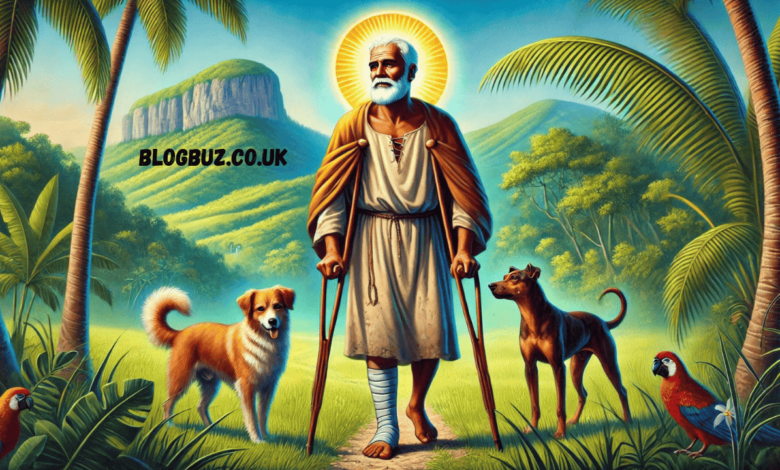St Lazarus Abba Kwi Cuban: A Beacon of Healing and Cultural Syncretism

Few figures are as pivotal and revered in the rich tapestry of Cuban spirituality as St Lazarus Abba Kwi Cuban. Known locally as Babalu Aye, St Lazarus represents a unique blend of Catholic and Afro-Cuban religious traditions, embodying the concepts of healing, resilience, and spiritual protection. This article delves into the veneration of St Lazarus Abba Kwi, exploring his role in Cuban culture and religious practices and his profound impact on his devotees in Cuba and globally.
Historical and Cultural Background
St Lazarus Abba Kwi, or Babalu Aye, is synonymous with healing and protection in Cuban Santería. Historically, Lazarus is a biblical figure resurrected by Jesus, symbolizing the power of faith over death. In Cuba, this symbolism encompasses protection against physical and spiritual ailments, making him a figure of immense reverence.
The Syncretic Nature of St. Lazarus
Cuban religious practices are characterized by syncretism, where elements of Catholicism blend seamlessly with African religious traditions brought by enslaved people during the colonial era. St Lazarus is a prime example, merging with the Yoruba deity Babalu Aye, which is associated with disease and healing. This syncretism reflects the dual spiritual heritage of many Cubans, embodying their ability to integrate and honor diverse religious elements.
Devotional Practices and Rituals
Devotion to St Lazarus is marked by elaborate rituals and offerings, which include food, candles, flowers, and cigars. These offerings are believed to secure blessings and protection from the saint. Notably, the annual pilgrimage to El Rincón on December 17th gathers thousands of followers who engage in various acts of devotion, such as crawling on hands and knees or carrying crosses, to show repentance and seek favors from the saint.
Symbolism in Iconography
St Lazarus is often depicted as an older man with crutches, accompanied by two dogs. This imagery highlights themes of suffering and healing, with the dogs symbolizing loyalty and protection. Such iconography is powerful within Cuban culture, emphasizing the saint’s role as a protector of the marginalized and those afflicted by illness.
The Role of St Lazarus in Health and Healing
In matters of health, St Lazarus Abba Kwi is a central figure. Devotees often seek his intercession for healing from various ailments, ranging from minor to severe. The faith in his power is profound, with many attributing miraculous recoveries to his intervention. This belief underscores his spiritual significance and enhances his followers’ emotional and psychological well-being, providing hope and communal support.
Cultural Impact and Festivities
The veneration of St Lazarus transcends the purely religious sphere, influencing Cuban social and cultural life. His feast day is not just a spiritual event but a major cultural celebration that includes music, dance, and communal gatherings, reflecting the enduring spirit of resilience and hope that he represents.
Global Influence
The Cuban diaspora has played a significant role in spreading the devotion to St Lazarus worldwide, particularly in areas with large Cuban communities like Miami. The traditions enthusiastically continue, illustrating the saint’s universal appeal and the emotional connection that transcends geographical boundaries.
Conclusion
St Lazarus Abba Kwi is a testament to the strength and complexity of Cuban spiritual and cultural identity. His role as a healer and protector resonates deeply with many, making him a symbol of resilience and hope. As Cubans continue to honor him, both on the island and worldwide, St Lazarus remains a vibrant part of their cultural heritage, embodying the syncretic nature of their religious beliefs and the universal human desire for healing and protection.
FAQs about St Lazarus Abba Kwi Cuban
Who is St Lazarus Abba Kwi?
St Lazarus Abba Kwi, also known as Babalu Aye in the Santería religion, is a revered figure in Cuban culture known for his association with healing and protection. He is syncretized with the Catholic Saint Lazarus, traditionally depicted as a poor man, accompanied by dogs, afflicted with sores.
What does St Lazarus represent in Cuban culture?
In Cuban culture, St Lazarus represents resilience, healing, and hope. He is revered as a protector of the sick and an influential figure who can intervene in times of hardship and illness.
How is St Lazarus celebrated in Cuba?
St Lazarus is celebrated on December 17th each year, marked by a significant pilgrimage to the shrine at El Rincón near Havana. Devotees participate in various rituals, including offerings and symbolic acts of penance, to honor him and seek his blessings.
What are everyday rituals and offerings made to St Lazarus?
Everyday rituals include lighting candles and offering food, flowers, and cigars. Many devotees also make promises (promises) to perform specific acts, such as charitable donations or pilgrimages, if their prayers are answered.
What is the significance of the dogs associated with St Lazarus?
The dogs that accompany depictions of St Lazarus are symbolic of loyalty and protection. They are said to represent his companions during his suffering and are often depicted licking his wounds, emphasizing themes of healing and compassion.
You May Also Read: Kaydence Gartman Alaska: A Story of Resilience, Recovery, and Advocacy




